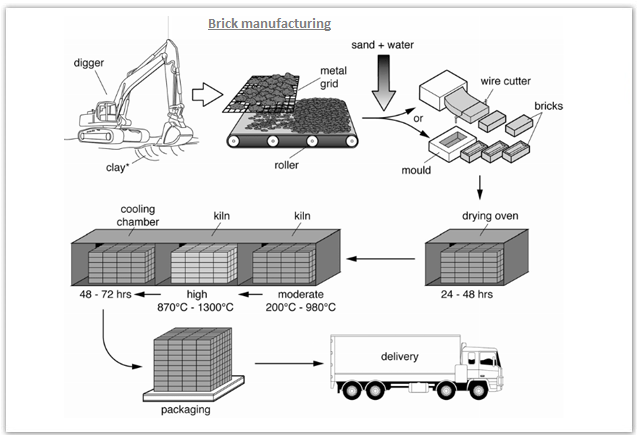» You should spend about 20 minutes on this task.
The diagram below shows the process by which bricks are manufactured for the building industry.
Summarise the information by selecting and reporting the main features, and make comparisons where relevant.
» Write at least 150 words.

Sample Answer 1:
The given diagram shows different stages of brick manufacturing for the building industries. Generally speaking, brick production involves 7 steps, starting from the digging stages and ending at the delivery stage.
As is given in the graph, the first step of brick manufacturing is digging the clay with a large digger. This clay is then filtered and processed in a roller machine and then mixed with sand and water. In the third stage, the mixture is either kept in a mould or cut in a wire cutter to make the raw shape of the bricks. In the next step, the shaped raw bricks are dried for 24 to 48 hours in a drying oven. After that, the dried raw bricks are kept in a kiln, both in moderate and high temperature, up to 1300 degree centigrade and then placed in a cooling chamber for about 48 to 72 hours. This process makes the brick to be packed and delivered in the final two steps. The delivery process is the final process of brick manufacturing and as it is noted, brick making is a moderately complex process that requires some predefined works to make it usable.
(Approximately 195 words)
Sample Answer 2:
The diagram gives information about the manufacturing process of construction bricks. Overall, brick manufacturing requires some controlled stages and complex equipment.
To begin with, the clay is collected by a digger machine and then the clay is passed through a metal grid to grind them. The smashed clays are transported to a roller and sand and water are mixed with this. The mixture later either moves through a brick cutter, which shape of bricks, or is placed into a mould in which the shape of a brick is formed. Afterwards, these brick-shaped parts are put into a drying oven and stay there for 24 to 48 hours. Next, they are transferred to the first kiln for heating, whose temperature is moderate, 200 to 980 C. After this, they are heated in the second kiln under the high temperature from 870-1300C. Subsequently, in a cooling chamber, they are cooled for two to three days before they are packaged and delivered to the construction sites.
To summarise, the whole process consists of generally seven steps during which the raw material is dried, heated, cooled and packaged.
[Written by Thomas]
Sample Answer 3:
The diagram illustrates the brick manufacturing process in an orderly manner starting from the digging of clay. As is seen in the given illustration, brick manufacturing is a complex process and involves 7 stages until they are ready to be sold in the market.
The process is initiated by digging clay with the help of a heavy machinery digger. This clay is then refined through the metal grid which throws the refined clay on the rollers. Sand and water are mixed and this mixture is either moulded or cut using a wire cutter to give the bricks a raw shape. These bricks are put in a drying oven for one to two days. The dried bricks are then passed to kilns with moderate (200 to 980 degree C) and high temperature (870 to 1300 degree C) and finally placed in a cooling chamber for 48-72 hours. After cooling down the bricks, they are placed on a pallet for packaging and to be loaded on a lorry for delivery.
In conclusion, the process of manufacturing bricks is a complex process which passes through several stages before the bricks are ready to be used.
(Written by Sami Satti)
